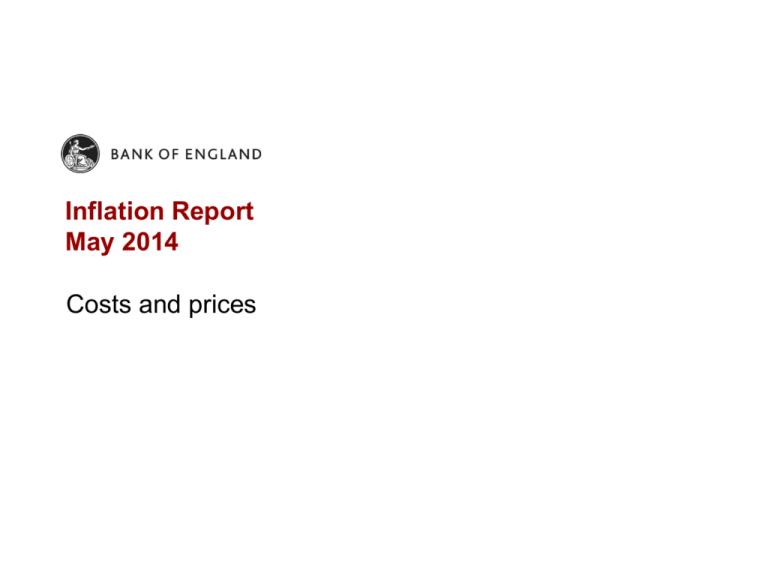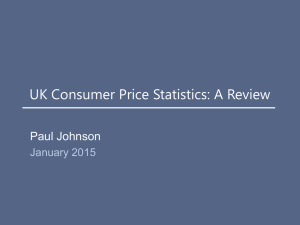
Inflation Report
May 2014
Costs and prices
Chart 4.1 Bank staff projection for near-term CPI inflation(a)
(a) The blue diamonds show Bank staff’s central projection for CPI inflation in January, February and March 2014 at the time of the February Inflation Report. The red diamonds show
the staff projection for April, May and June 2014. The bands on each side of the blue and red diamonds show the root mean squared error of projections for CPI inflation one, two
and three months ahead made since 2004.
Chart 4.2 Contributions to CPI inflation(a)
(a) Monthly contributions to annual CPI inflation. Data are non seasonally adjusted.
(b) Calculated as the difference between the total contribution of goods or services to CPI inflation and the contributions to CPI inflation from the goods or services identified in the chart.
Chart 4.3 Sterling effective exchange rate, UK import prices
and foreign export prices excluding fuel
Sources: Bank of England, CEIC, Eurostat, ONS, Thomson Reuters Datastream and Bank calculations.
(a) Goods and services deflator excluding fuels and the impact of MTIC fraud.
(b) Domestic currency export prices of goods and services of 52 countries weighted according to their shares in UK imports. The sample does not include any major oil exporters.
In 2013 Q4, export prices for Iceland, Pakistan, the Philippines, Switzerland and Turkey are assumed to grow at the same rate as export prices in the rest of the world.
Chart 4.4 US dollar oil and commodity prices
Sources: Bloomberg, S&P indices and Thomson Reuters Datastream.
(a) US dollar Brent forward prices for delivery in 10–21 days’ time.
(b) Calculated using S&P US dollar commodity price indices.
(c) Total agriculture and livestock S&P commodity index.
Chart 4.5 Private sector nominal earnings and output
per worker
Sources: ONS and Bank calculations.
(a) AWE total pay. The diamond shows data for the two months to February 2014.
(b) The diamond is based on the Bank staff’s projection for private sector output per worker in 2014 Q1. The error band around that forecast is wide.
Chart 4.6 Single-month measure of private sector total
earnings and illustration of base effects(a)
Sources: ONS and Bank calculations.
(a) Private sector AWE total pay.
Chart 4.7 Private sector unit labour costs(a)
Sources: ONS and Bank calculations.
(a)
(b)
(c)
(d)
Contributions do not sum to total due to the method of calculation.
Estimated labour costs per worker as defined in footnote (c) divided by market sector output per worker.
Calculated using private sector AWE data adjusted using the ratio of private sector employee compensation to wages and salaries.
Market sector output per worker.
Chart 4.8 Estimate of consumer-facing companies’ margins
relative to its average since 2000(a)
Sources: ONS and Bank calculations.
(a) Margins are estimated using the consumer prices index (which has been seasonally adjusted by Bank staff) and an estimate of total costs for consumer-facing companies. The
estimate of costs is constructed by weighting together energy costs (CPI sub-indices for electricity, gas, other fuels, fuels and lubricants; 10%), UK import prices excluding fuel (shown in
Chart 4.3; 25%), private sector unit labour costs (shown in Chart 4.7; 55%) and indirect taxes (measured using the basic price adjustment; 10%). The weights are based on the energy
and import price intensity of the CPI and the contribution of indirect taxes to CPI inflation; the weight for labour costs is calculated as a residual.
Chart 4.9 Companies’ expected changes in own prices over
the next year(a)
Sources: CBI (all rights reserved) and ONS.
(a) Companies are asked: ‘What percentage change is expected to occur over the next twelve months in your own average output price for goods sold into UK markets?’.
(b) CBI data for the manufacturing, business/consumer services and distribution sectors, weighted together using nominal shares in value added.
Tables
Table 4.A Monitoring the MPC’s key judgements
Table 4.B Sterling oil and wholesale gas prices(a)
Sources: Bank of England, Bloomberg, Thomson Reuters Datastream and Bank calculations.
(a) Futures prices at the time of the May Inflation Report are averages during the fifteen working days to 7 May 2014. Futures prices at the time of the February Inflation Report are
averages during the fifteen working days to 5 February 2014.
(b) Brent forward prices for delivery in 10–21 days’ time converted into sterling.
(c) One-day forward price of UK natural gas.
Table 4.C Private sector earnings and indicators of future
pay growth
Sources: Bank of England, CBI (all rights reserved), Incomes Data Services, KPMG/REC/Markit, the Labour Research Department, ONS and XpertHR.
(a)
(b)
(c)
(d)
(e)
(f)
Official estimates for 2014 Q1 show data in the two months to February.
Private sector total pay excluding bonuses and arrears of pay.
Percentage points. The bonus contribution does not always equal the difference between total AWE growth and AWE regular pay growth due to rounding.
Average over the past twelve months, based on monthly data.
Expected percentage change in wage/salary cost per person employed (including overtime and bonuses) over the next twelve months for companies in the manufacturing,
business/consumer services and distribution sectors, weighted together using nominal shares in value added.
Net balance of companies reporting that average salaries awarded to staff placed in permanent positions were higher than one month ago.
Table 4.D Indicators of inflation expectations(a)
Sources: Bank of England, Barclays Capital, Bloomberg, CBI (all rights reserved), Citigroup, GfK NOP, ONS, YouGov and Bank calculations.
(a) Data are non seasonally adjusted.
(b) Dates in parentheses indicate start date of the data series.
(c) Financial markets data are averages from 1 April–7 May. YouGov/Citigroup data are for April.
(d) The household surveys ask about expected changes in prices but do not reference a specific price index, and the measures are based on the median estimated price change.
(e) CBI data for the manufacturing, business/consumer services and distribution sectors, weighted together using nominal shares in value added. Companies are asked about the
expected percentage price change over the coming twelve months in the markets in which they compete.
(f) Instantaneous RPI inflation one year ahead implied from swaps.
(g) Bank’s survey of external forecasters, inflation rate three years ahead.
(h) Instantaneous RPI inflation three years ahead implied from swaps.
(i) Five-year, five-year forward RPI inflation implied from swaps.











